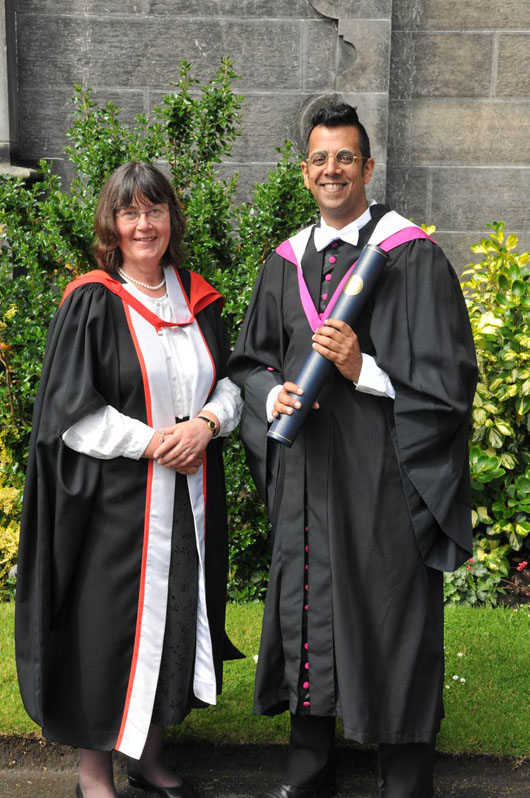Laureation Address – Dr Simon Singh
Dr Simon Singh
Honorary Degree of Doctor of Science
Laureation by Professor Alyson Tobin
School of Biology
Friday 22 June 2012

Chancellor, it is my privilege to present for the Degree of Doctor of Science, honoris causa, Dr Simon Singh.
Simon Singh decided at the age of nine that he was going to become a nuclear physicist. His early interest in science was due in no small part to the inspiring TV presenters who were around at that time, such as Carl Sagan, Patrick Moore, James Burke and Heinz Wolff. These were his role models. He now follows their lead in inspiring new generations of scientists through his writing and broadcasting.
Simon Singh did, indeed, fulfil his childhood ambition. He read Physics for his first degree at Imperial College, London and gained his PhD in Particle Physics at Cambridge University. Most of his PhD research was carried out at CERN in Geneva where he worked on the Super Proton Synchrotron, accelerating protons and anti-protons to produce collisions that would hopefully release the elusive ‘top quark’. Sadly, it didn’t. The synchrotron was too weak, but it went on to a new life and career as an integral part of the Large Hadron Collider. Simon also made a career change and became an integral part of the BBC’s Science Department, producing and directing programmes for Tomorrow’s World and Horizon – the programmes that had inspired him as a child.
It was his BBC Horizon documentary on ‘Fermat’s Last Theorem’ that brought him his first major acclaim, a BAFTA for Best Documentary and a nomination for an Emmy. This led to his first foray into writing, with the first mathematics book to become a number one UK bestseller. The film and the book tell the story of Professor Andrew Wiles’ life-long, and eventually successful, attempt to prove Fermat’s Last Theorem, which is:
the equation xn + yn = zn cannot be true where n is greater than 2.
Hardly, on the face of it, the stuff of bestsellers or of BAFTAs.
But Simon Singh took us on an entertaining and truly educational journey through mathematics, from Pythagoras to Pierre de Fermat and finally to Andrew Wiles’ proof. Simon Singh manages to ‘hook you in’ right from the start. Who could forget the opening sequence of the Horizon documentary where Wiles recalls the moment when he knew had he completed his work and he turns away from the camera, overcome by emotion.
Simon Singh followed this success with The Code Book. The Secret History of Codes and Code-breaking and then Big Bang where he once again combined his skills as a storyteller with his ability to explain ‘difficult science’ in simple and readable terms. Like all good teachers he leaves the reader feeling so much more knowledgeable about the subject and he manages to entertain without falling into the trap of ‘dumbing-down’.
We got a taste of this in 2006 when Simon Singh came to St Andrews to give a public lecture about the Big Bang Theory to a packed audience in the Physics building. We were treated to a demonstration of the ‘gherkinator’– the live and rather dramatic electrocution of a pickled gherkin, illustrating the spectral properties of sodium and providing evidence for the expanding universe. A definite ‘don’t try this at home’ moment, but an unforgettable science lesson for everyone who was there.
Simon Singh’s most recent book, Trick or Treatment? Alternative Medicine on Trial has generated CERN-like collisions of the less favourable kind. The British Chiropractic Association raised a libel action against him for an article he wrote in the Guardian criticizing claims about the efficacy of spinal manipulation for the treatment of children’s illnesses. The case lasted for two years and cost over £200,000 but Singh didn’t back down and eventually the BCA withdrew its action. It has drawn considerable attention to the libel laws in England and Wales and led to a widespread campaign to defend the right of scientists to publish on controversial topics without fear of litigation. This has resulted in a Westminster Bill to amend the Law on Defamation that is currently passing through Parliament, bringing some level of reassurance to those who publish articles in the press, Internet and indeed in academic journals.
There are some in this audience who have benefited very directly from Simon Singh’s inspiration. In 2002 he founded and funded the Undergraduate Ambassador’s Scheme that has provided the opportunity for science and mathematics undergraduates to earn academic credit by working in a local school. We adopted the programme 5 years ago and have now sent over 200 students – including some of our new Mathematics graduates – into schools across Fife and Tayside, providing ambassadors to inspire young people to study science. It brings enormous benefits by building up confidence in our students, breaking down the barriers between school and university and helping our students to make that first step into science communication themselves. As a testimony to the programme and of Simon Singh’s vision in founding it, I will leave it to the words of some of our students to sum it up:
“I wasn’t viewed as ‘just a student’ but as a colleague, a ‘Miss’, someone to be respected. I matured in this environment.”
“A child drew me a picture saying, ‘I love science’, with a drawing of what she had learned in my lesson.”
“I have learned that my enthusiasm for learning can be contagious and helps to inspire others. That I really enjoy teaching.”
Chancellor, in recognition of his major contribution to science communication, education and academic freedom I invite you to confer on Dr Simon Singh the Degree of Doctor of Science, honoris causa.
Category University news